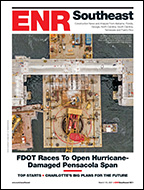Federal regulators have run out of time to issue safety violations for the May 30 collapse of a Kodiak tower crane in New York City, which killed two workers. Investigators there did not find evidence that employers failed to comply with national safety codes, a source at the Labor Dept. says.
The Occupational Safety and Health Administration issued no citations for alleged violations “to any company involved in the matter,” says the source, who asked to remain anonymous. Other agencies still have open investigations. Local prosecutors continue to probe possible criminal activity in parallel with a March 15 collapse that killed seven people, allegedly due to bad rigging, OSHA found. The city’s Dept. of Buildings also is studying both collapses.
In the absence of OSHA charges, a root cause remains unclear, although sources close to the accident point to a weld holding down a replacement turntable assembly ordered from China after a 2007 lightning storm damaged the crane.
How that weld failed is still not fully understood. “The city still has the crane impounded, so we really can’t look at anything,” says James F. Lomma, owner of Queens-based New York Crane, which supplied the Kodiak. “We want to make sure that something like this never happens again.” The bearing supplier was certified to quality-control standards by the International Organization for Standardization (ISO), says another source.
Investigators are now pointing to a lack of standards for crane repair. New York Crane decided to replace the Kodiak’s turntable in 2007 after it was damaged by the storm, according to company records obtained by ENR. The turntable damage was not apparent at first. In the weeks after the storm, workers noticed that the crane was vibrating and making noise, prompting a top-down inspection. The crane was taken apart, and forensic engineers found spalling in the bearing raceways and a circumferential crack but they could not examine it because it was torched open to remove the works. Forensic consultant Lucius Pitkin Inc. took ball bearings and spacers from the unit and examined them under a scanning-electron microscope.
That investigation found evidence of electrical arcing consistent with lightning damage, and the turntable suffered progressive failure as workers used the crane. The report concluded that because disassembling and inspecting turntables is not practical for an in-service crane, “following lightning strikes, crane turntable bearings should be monitored for increased noise and vibrations” and replaced accordingly. The repair was done to the maker’s specifications, says Lomma, who notes that lightning strikes are common but turntable failures are not.
New York City officials hosted an international crane conference on Oct. 16, and one of the main points was “the tracking of crane parts... and tracking those parts across state lines,” says Tony Sclafani, Dept. of Buildings spokesman. “That would be very beneficial for municipalities across the country... because there is not a national standard for repairs.”
With these and other probes still open, a large number of responses to a proposed U.S. regulation for cranes convinced OSHA to push back its comment period, which was to expire on Dec. 8. The public now has until Jan. 22, 2009.



Post a comment to this article
Report Abusive Comment